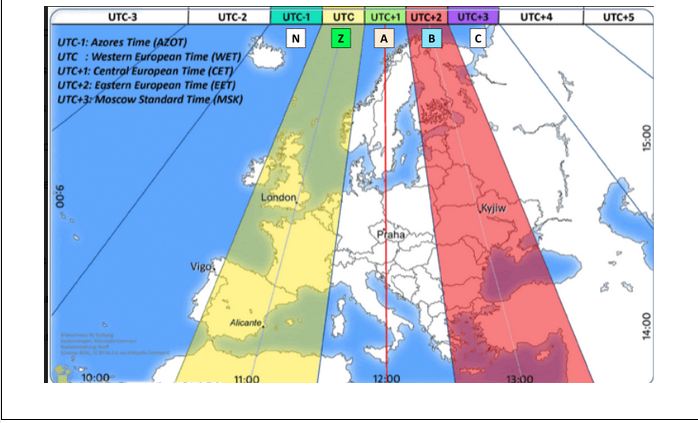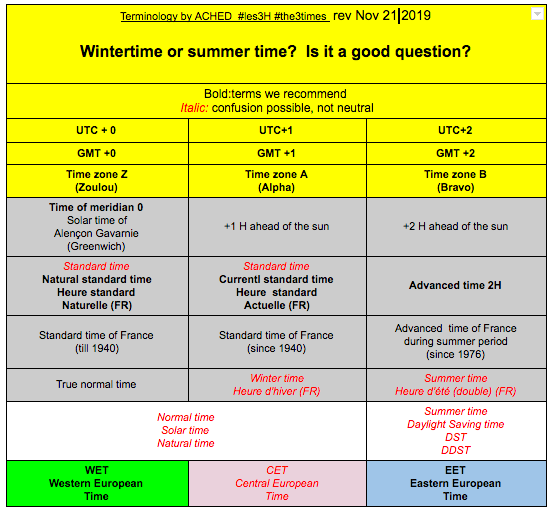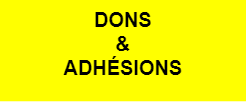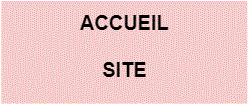
Courtesy
image
As we see on this map, metropolitan France (like Spain and some other countries) should have the same legal time as the United Kingdom and Portugal, namely GMT (UTC) and not GMT + 1 ( UTC +1).
Since 1945, France is assigned to the CET timezone, Continental European Time, code A (Alpha), time of Continental Europe. Its current standard time is UTC + 1.
But France should be in the WET zone (code Z, Zulu), Western European Time, Western Europe time. The standard time for this time zone is UTC (GMT). UTC is the true normal time of France, its natural standard time.
This natural standard time is the solar time along meridian 0 which passes through Greenwich in England, Alençon and Gavarnie in France and Alicante in Spain. It is the stime closest to the solar time of all French people in metropolitan France.
Compared to this natural standard time, the French legal time carries TWO advancements: a one-hour advance during the "winter" period and a two-hour advance during the "summer" period.
|
Solar time in Alençon
standard natural time
|
6 |
8 |
10 |
12 |
16 |
18 |
20 |
22 |
24 |
|
Time in "winter" period,
current standard time
|
7 |
9 |
11 |
13 |
17 |
19 |
21 |
23 |
1 |
Time in "summer" period,
current daylight saving time
|
8 |
10 |
12 |
14 |
18 |
20 |
22 |
0 |
2
|
During the summer period, with "double" summer time, French clocks show 14 hours when it is actually noon. Or how to look for noon when two o'clock ...
During the summer period, currently, France has the standard time of the EET time zone (code B, Bravo), Eastern European Time, UTC + 2 or GMT + 2, which meridian passes near Kiev in Ukraine.
A bit of history ...
The basis of the system stated in 1884 is that within a 15 ° time spanl, all the clocks indicate the same time: the average solar time of the central meridian of the time zone(Meridian of reference). The meridian of the Z / WET timezone is the 0 meridian that passes through Alençon and Gavarnie in France, Greenwich in England, Alicante in Spain.
From 1916 and between the two world wars, many European countries, including France and Spain, used a system of "single summer time" (one hour ahead during "summer" - in fact for five months then).
During the Second World War, occupied France lost control of its time and was set to Berlin time, either UTC + 1, or UTC + 2 when Germany advanced. Two consecutive winters 40-41 and 41-42, it even happened that France spent the winter in UTC + 2. In 1945, France did not return to UTC but remained on at Berlin time. France and Germany (West) stopped changing their time seasonally and stayed at the same fixed time, UTC + 1. Spain, Belgium and Benelux also under Nazi influence until late 45, had also lost their pre-war time, suffered UTC + 1 / UTC + 2 during the war and also remained at UTC + 1.
After 45, some countries (Italy, United Kingdom, Ireland) continued to advance under "simple" summer time systems. Except UK spent 3 years at UTC + 1 from 1968 to 71 and then returned to seasonal changes. France was during this period somehow at an advanced time, a "single" summer time blocked in summer position. In 1976, France added an additional seasonal advance (change) for six months of the year ... then for seven months since 1996. In the wake of France, other countries (re) began to make seasonal progress. As early as the 1980s, all countries in the European Union had a time change system and this is still the case today. It is even a condition of entry into the European Union.
In 2019, France, Spain and the Benelux use "double", + 2H, summer time compared to their natural standard time. France, Spain, Belgium, the Netherlands and Luxembourg are sometimes called "The Club of 5": the club of 5 European countries with a double summer time, advanced 2 hours in summer compared to at their standard time of origin / natural. (Portugal also used "double" summer time, but only for four years, from 1992 to 1996). Other countries in the European Union have "single" summer time systems.
To conclude ...
Saying winter time and summer time is relatively necessary to be understood talking to a French person, but we are of the opinion that their use of those terms should be restricted especially in the questions of polls and in the official texts. When we say summer time, what is it? the system? time? the simple one? the double one? When we say winter time / summer time, how can we not think of the winter / summer seasons? And do not we forget the third hour: the UTC.
Because the times of France are more than 2, winter / summer,
but actually there are 3 times: UTC / UTC + 1 / UTC + 2
# les3H
Natural standard time, standard time, advanced time + 2H
Standard time is by convention that of the time zone in the winter. Contrary to American they is no notation S for Standard D for Daylight Daving time like the US one (example CDT, CST).
It is risky to talk about standard time as they have changed over the course of history and could change again. It is nevertheless very handy. In the case of France, it is further complicated because we have several standard hours. We will be saying natural standard time for UTC + 0 to distinguish it from UTC + 1 the current standard time.
UTC + 0 is the natural standard time. In French heure standard naturelle.
UTC + 1 is the current standard time. In French, heure standard actuelle.
Standard time UTC + 1 and UTC + 2 are advanced times.
UTC + 2 is a the advanced time for the summer period. In English Advanced time, or DST or summertime, or double-summertime. Double summer time is part of the name of our association)
To limit confusion it is useful to speak in UTC, UTC + 1, UTC + 2.
The name GMT is obsolete since 1972 but everyone understands and we still find it in the official documents of the European Union of 2017 ...
The codes Z, A, B have the advantage of being a short notation but less known.
If we use the zones WET, CET and EET, it is good to know that France should be in WET but is not there.

Note
1:
References
/ Glossary,
outside of
France:
Standard
time :
is
the legal
time given
to a place,
corresponding
to the mean
solar
time of a
nearby
meridian or
a
neighboring
one.
According
to Merriam
Webster
https://www.merriam-webster.com/dictionary/standard%20time
Natural
Standard time
:
is
the standard time
given
by the
closest
meridian .
When
are current
and natural standard
times not the
same ?
when a country
or state adopts
a legal time
that is not
the one of the
closest meridian.
|
Places
where
standard time
is not the natural
standard time
France,
Spain,
Belgium, Netherlands
Saskatchewan
in Canada (http://heure-ete.net/CanadaFR)
Sometimes it
is debatable
as a country
can be half
way between 2
meridians or extend
on more than 2
stripes
Example:
Luxembourg
is a debatable
one
as it lays
half
way between 2
meridians
Sometimes
part
of a country
or
a state is not
having natural
time .
Sometimes
it is an
area with low
populatoin
density
Example:
Greece
Sometimes
the
country spans
on more than 2
natural standard
times and part
of country
has
an
important
population not
under
natural standard
time:
Example:
China
|
#NaturalStandardTime
Updated
on Jan
31,
2020.




